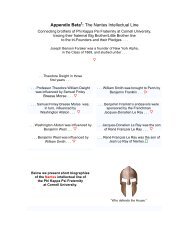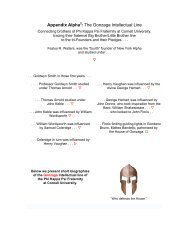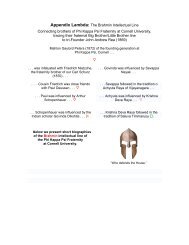Gondar - Phi Kappa Psi
Gondar - Phi Kappa Psi
Gondar - Phi Kappa Psi
Create successful ePaper yourself
Turn your PDF publications into a flip-book with our unique Google optimized e-Paper software.
Susenyos campaigned against the Agaw in the north, the encroaching<br />
Oromo in the south, and is said in his Royal Chronicle to have made his power<br />
felt along his western frontier from Fazogli north to Suakin.<br />
He was interested in Catholicism, in part due to Pedro Páez' persuasion,<br />
but also hoping for military help from Portugal and Spain (in union at the time of<br />
Susenyo's reign). Some decades earlier, in 1541, Christopher da Gama (son of<br />
the legendary Portuguese explorer Vasco da Gama) had been in charge of a<br />
military expedition to save the Ethiopian emperor Gelawdewos from the<br />
onslaught of Ahmed Gragn, a Muslim Imam who almost destroyed the existence<br />
of the Ethiopian state. Susenyos hoped to receive a new contingent of wellarmed<br />
European soldiers, this time against another enemy, the Oromo who were<br />
invading from the south, and to put down constant internal rebellion. He showed<br />
the Jesuit missionaries his favor by a number of land grants, most importantly<br />
those at Gorgora, located on a peninsula on the northern shore of Lake Tana.<br />
In 1613, Susenyos sent a mission heading for Madrid and Vatican City,<br />
led by Fr. Antonio Fernandes. The plan was to head south, in an attempt to reach<br />
Malindi, a port on the Indian Ocean in what is Kenya today, hoping to break<br />
through the effective blockade that the Ottoman conquests had created around<br />
the Ethiopian empire by sailing all the way around the southern tip of Africa.<br />
However, they failed to reach Malindi, due to delays caused by local Christians<br />
hostile to the mission.<br />
Despite several letters from Susenyos to the King of Spain (and Portugal),<br />
<strong>Phi</strong>lip III, asking for military help, no Spanish or Portuguese soldiers ever arrived.<br />
Even so, Susenyos at last converted to Catholicism in 1622 in a public<br />
ceremony, and separated himself from all of his wives and concubines except for<br />
his first wife. However, the tolerant and sensitive Pedro Paez died soon<br />
afterwards, and his replacement Alfonso Mendez, who arrived at Massawa on<br />
January 24, 1624, proved to be haughty and less tolerant of traditional practices.<br />
Strife and rebellions over the enforced changes began within days of Mendez'<br />
public ceremony in 1626, where he proclaimed the primacy of Rome and<br />
condemned local practices, suppressing even the use of the Ethiopian calendar.<br />
In 1630, the Viceroy of Begemder, Sarsa Krestos, proclaimed Susenyos's<br />
son Fasilides emperor; Sarsa Krestos was promptly captured and hanged. Two<br />
years later, Susenyos's brother Malta Krestos revolted in Lasta, which was put<br />
down at the cost of 8,000 lives. This purposeless loss of life depressed<br />
Susenyos, and on returning to his palace at Dankaz, he granted his subjects<br />
freedom of worship, in effect restoring the traditional Ethiopian Church.<br />
In 1621, Susneyos publicly announced his adherence to the Latin faith, a<br />
strategy to reinforce his political power and his independence from the influential<br />
Orthodox clergy. A consequence of the public conversion of the king was the<br />
arrival of a growing number of Jesuit priests intent on rapidly introducing Catholic






